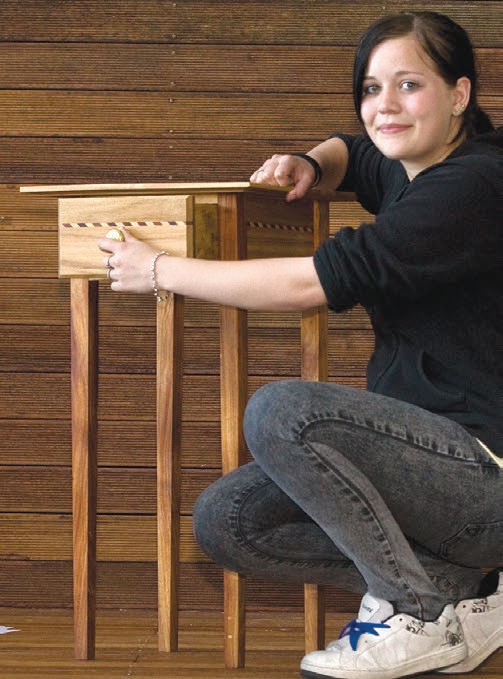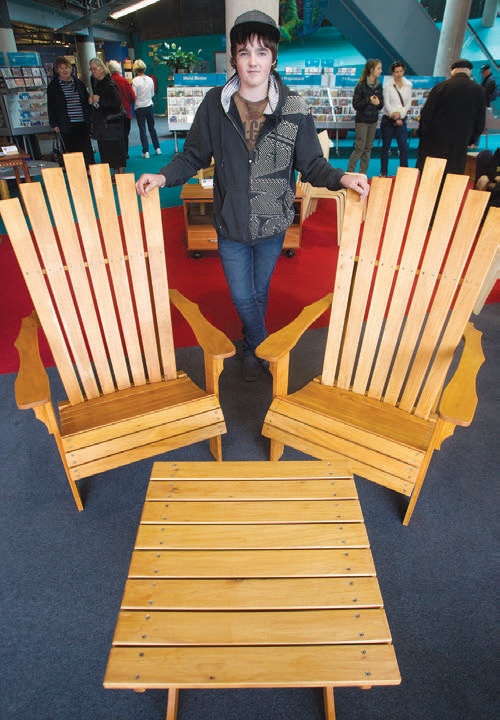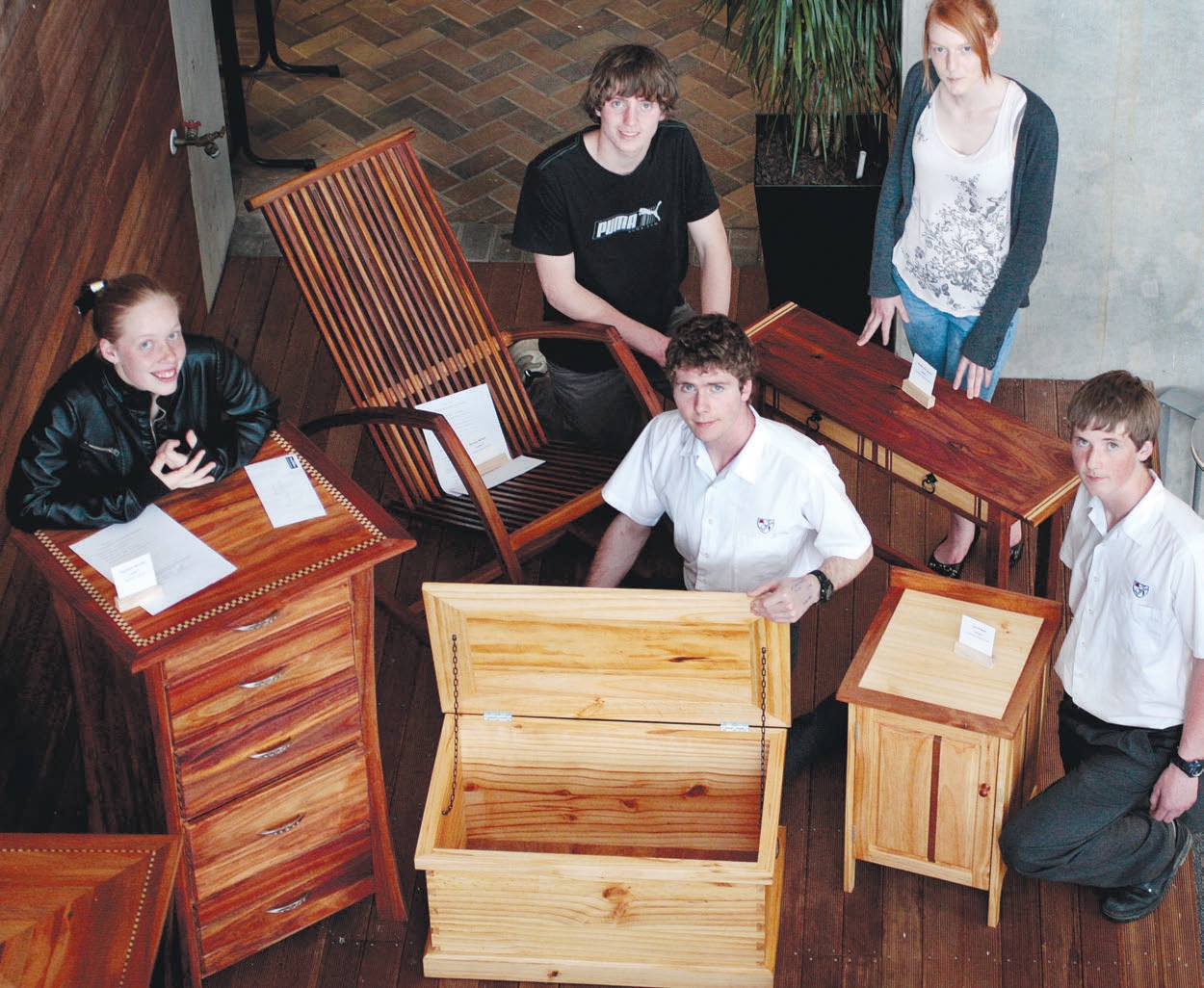Working on the wood work
Denis Hocking, New Zealand Tree Grower May 2014.
I am sure that many farm foresters have meditated on ways of increasing awareness and enthusiasm for the various special purpose timbers we grow. I know that I am not the only one who has thought about the possibilities of getting secondary school students using some of these timbers. Perhaps what others have not done is take it the next step and try to promote the use of these timbers with a school wood working competition. Well, we have in Middle Districts, and it has been both a rewarding and also a very frustrating process.
About 10 years ago I started supplying various timbers to the furniture design and manufacturing course at our local polytechnic, UCOL. This worked well and the timbers, mainly various eucalypts, blackwood and some macrocarpa, were enthusiastically received by the course tutors. A variety of grades and dimensions were supplied at what might be described as mate’s rates, recognising that this timber would be used in a wide variety of dimensions and items with quite a bit being a victim of the learning process. It also resulted in a useful relationship between the branch and the UCOL furniture people.
Organising a competition
The next step was to see if we could not extend this arrangement to some of the local schools with wood working courses. Might we perhaps organise a wood working competition to encourage students to use different timbers? This developed out of discussion with various Middle Districts members and UCOL staff. The first step in 2009 was to meet our regional technical teachers group and discuss possibilities and levels of support.
The fact that this group was led by a very enthusiastic and energetic teacher was a good start. In addition, they met at about three monthly intervals, although as happens with such organisations only a small minority of all technology teachers seemed to be involved and actually attended these meetings. After a few meetings various points emerged –


- There did seem to be sufficient interest to proceed
- The Kawerau wood skills competition provided a useful guide for competition rules
- Our younger generation are a mercenary, rather than idealistic bunch, and some worthwhile prizes were needed so we settled on $500, $300 and $100 values for first, second and third
- The competition would be divided into two divisions – NCEA levels 1/2 and NCEA level 3, each with first, second and third prizes
- The UCOL course tutors could provide a very credible judging panel, an important consideration in any competition
- We should not try to restrict competitors to using our timbers in the competition, rather the rules would specify sustainably grown, decorative timbers, a deliberate catch-all approach
- UCOL could also be useful in preparing publicity material, and we had hoped that their school liaison staff might help promote the competition, but unfortunately this has not happened
- It promised to be a suitably photogenic event for local media coverage.
We also went looking for sponsorship and in the first two years Bunnings Warehouse supported us quite generously. Unfortunately, they withdrew after two years. More recently a local electrical tools retailer, Smith-Pilling, has provided some generous assistance. UCOL has picked up half the cost of the prizes over the last two of years along with some in-kind support, most notably the judging.
Sourcing timber
We worked mainly through the technical teachers group to generate interest in timber purchases and participation in the competition. Three or four schools came on board very quickly, reflecting the attitude and energy of their wood working teachers. They were keen to get the timbers, which were supplied ungraded at $600 a cubic metre.
Blackwood was probably the most popular, but various eucalypts were also well received. Macrocarpa, the most readily available timber from our members, is already being used by many schools, along with a surprising amount of fibreboard. I should mention here Don Tantrum’s role in supplying and distributing timber to the schools. He has been a source of all kinds of woods.
First competition
The first competition was held in October 2010. Only three or four schools had entries and Palmerston North’s Awatapu College pretty much swept the board. It was no coincidence that this school’s teacher was also the chairman of that important technical teachers group, but I will vouch for the integrity and independence of our UCOL judges.
For the first two years we used the UCOL facilities for the prize-giving, but from the start we managed to get the entry items displayed for a fortnight at the Palmerston North City Council public library. Subsequently the judging, prize-giving and display have all been at the library, an excellent venue for publicity purposes.
Media interest and displaying work
True to predictions it also proved to be a popular event for the local newspaper, the Manawatu Standard, and the stable of small local papers. It provided some great photographic opportunities. Sadly, none of the outside papers have ever shown any interest despite regular notification. There have been some real buzzes from the competition, but none more so than seeing the quality and diversity of the pieces entered for the competition. The students are doing some good work, and perhaps the best indicator of this has been the number of enquiries about purchase of items made by the public while they have been on display.
It has been a real pleasure getting this work on public display and also seeing the excitement and anticipation among the entrants at the prize-giving. We may not have achieved the numbers we hoped for, but the enthusiasm of those who do get involved is impressive. And yes, they do make very good use of the timbers we supply. It is also interesting to see the number of girls doing spectacularly good work.

Hard work
However, keeping this competition afloat has not been easy. If you want to run such a competition be prepared to be forever nagging people – repeated emails, phone calls, trying to get posters or certificates done or a response to earlier enquiries and arrangements. Need I point out that in a voluntary organisation you need to be prepared to do 90 per cent of the work if you expect your bright ideas to actually fly.
As noted, we are very dependent on the energy and enthusiasm of the teachers. Three at Awatapu College, Longburn Adventist College and Feilding High School have been excellent – I am not sure the same can be said for others. A year ago I wrote to the technology teachers at all 20 of the region’s secondary schools offering wood working, explaining the competition and enclosing a CD with photographs of all the previous prize winners. I did not receive a single response. I did not expect 20 replies, but zero was a disappointment.
Worthwhile
On balance I think the competition has been well worthwhile, but it has been a lot more work than I expected. Originally I fantasised about the competition evolving into a series of regional competitions with a grand prize for the best of the best. Perhaps this could have been done in conjunction with the Kawerau competitions. This may still be theoretically possible, but it might require a full-time coordinator.
Every year the branch has briefly discussed the competition at the AGM, with reservations expressed. It costs the branch about $1,000 each year, and this is still tentatively available for the next three years. But make no mistake, it is hard work. Frustratingly few supporters seem to leap out of the woodwork. While it has been a pleasure working with those who do, most of the time spent on the competition is chasing up unanswered emails, talking to answer-phones, and nagging about jobs that have not been done.
Undoubtedly the prize-givings have been the highs, seeing the quality of the work and enthusiasm of the students, but it can be a struggle getting there. One little extra worth mentioning was an enquiry we got from a student last year after some preliminary publicity in the local paper. It was the student who took the initiative, entered his piece, dragged his teacher along, and took away second prize. Now that was worth waiting for.
Advice to make it work
My advice to any branch or person thinking about trying to emulate our efforts is −
- Locate those enthusiastic and energetic teachers
- Consider the possibility of a competition for just one school first, but pick it carefully
- Organise a credible judging panel, as well as a clear description of the judging process and allocation of points
- Look at the possibilities of supplying timbers to interested schools
- Feel free to contact us for the rules and process we have used for our competition
- Do not expect such a competition to spontaneously grow and develop, it will take a lot of work and persistence.
Denis Hocking is a former NZFFA executive member, currently chairman of Middle Districts FFA, who grows a variety of timber species on sand country near Bulls.

 Farm Forestry New Zealand
Farm Forestry New Zealand